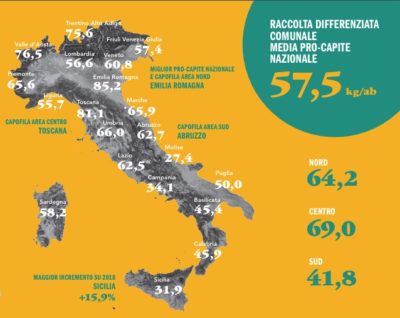Among the objectives achieved over time and challenges for the future, the ecological management of packaging in Italy is registering dizzying numbers. Demonstrating that the interest in the topic is very high and that, although it can always be improved, it is nevertheless on the right track. To say this are the data recorded by Ispra, the Higher Institute for Environmental Protection and Research, which in the latest (in order of time) Urban Waste Report 2019 highlights that in 2018 “the release for consumption of packaging on the national market […] it stands at almost 13.3 million tons, compared to 2017, an increase of about 109 thousand tons (+ 0.8%) “. At the same time, “the quantity of waste sent for recovery […] is equal to almost 10.7 million tons, recording an increase of 4.8% compared to 2017, corresponding in quantitative terms to 485 thousand tons” .
In detail, “the share relating to recycling from public surfaces recorded an increase of 6% compared to 2017, equal to approximately 268 thousand tons” and in this case paper and glass respectively, 37.4% and 39.7% of the total recycled from public surfaces. Instead, “the quantity of packaging waste initiated for energy recovery, coming from public surface alone, is equal to over 1.4 million tons. In contrast to the 2016-2017 two-year period, there is an increase of 4.4%, corresponding to about 60 thousand tons. ”Here then“ the most energy-recovered fractions are plastic (69% of the total) and paper (26%) ”.
Paper and cardboard in the ecological management of packaging
It is easy to see how, whether it is recycling or energy recovery, paper always compares the materials most likely to be reused. It’s not a casuality. According to the aforementioned Report, in fact, “Cellulosic packaging waste is confirmed as the most recovered fraction in 2018, constituting 40.7% of the total recovered”. According to the research L’Italia del riciclo 2019, then, “the recycling of paper and cardboard packaging increased from 3,291 kt in 2009 to 3,981 kt in 2018, with an increase of 690 kt equal to 21%. paper and cardboard released for consumption, the percentage of those sent for recycling has increased from 80 to 81%, against a European target of 75% by 2025 and 85% by 2030 “.

cushionPaper ™, an innovative product (and in step with trends)
Very promising data, which some manufacturing companies are looking at with interest in view of the production of ecological packaging, in paper and cardboard, 100% recycled and recyclable, for savings that are both environmental and economic for the entire “life” of the product. This is the case of cushionPaper™, an innovative product that presents itself as the best paper alternative to plastic: its entire completely eco-sustainable supply chain makes it an innovative product capable of satisfying all the needs of those who use it. So let’s see together how the production, use and disposal of this product takes place:
A production
aware
As we have mentioned, cushionPaper™ stands as the best substitute for plastic among packaging materials. Its structure is in fact composed of sheets and waves in recycled and recyclable paper, therefore inserted in a context of circular economy, while the raw material used is FSC® certified. The latter is an international, independent and third party certification, specific for the forest sector and products – woody and non-woody – derived from forests: it guarantees that the product with the FSC label comes from a forest and a supply chain of procurement managed in a responsible and sustainable way.
Simple to use
eliminates waste
Thanks to an innovative technology, cushionPaper™ is a simple product to use. On the one hand, therefore, it does not impose the obligation of specific training for the operators assigned to its use, while on the other it guarantees a real elimination of waste due to the use of equipment, molds and dedicated design. In sheets or reels, the product can be easily positioned at the packaging station and can be used manually by anyone who deals with packaging at the company that uses it.
A life
after cushionPaper™
And once used, cushionPaper™ never ceases to be functional: flexible and resistant at the same time, it can in fact be reused to pack new products to be shipped without losing the return. If, on the other hand, it is inserted in a disposal process, cushionPaper ™ is a winner in the challenge of eco-compatibility with respect to all products used for packaging: in fact, for the same volume, it reduces CO2 emissions and problems related to disposal.
